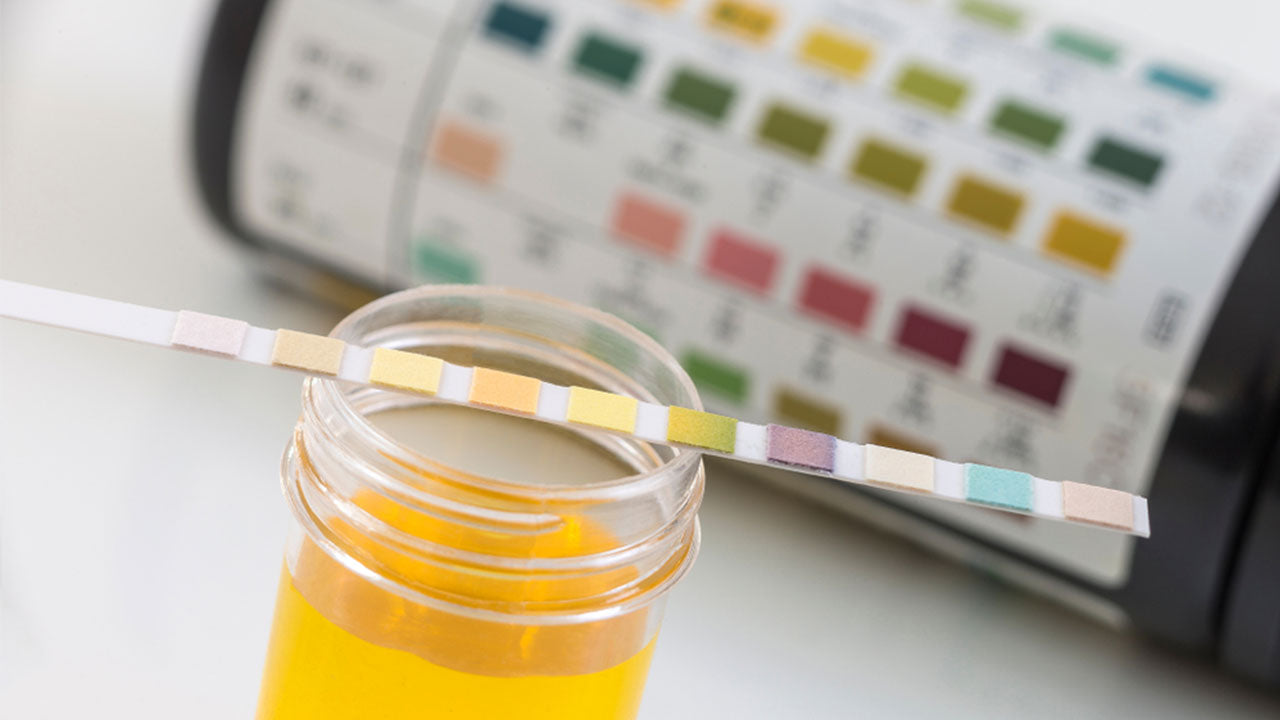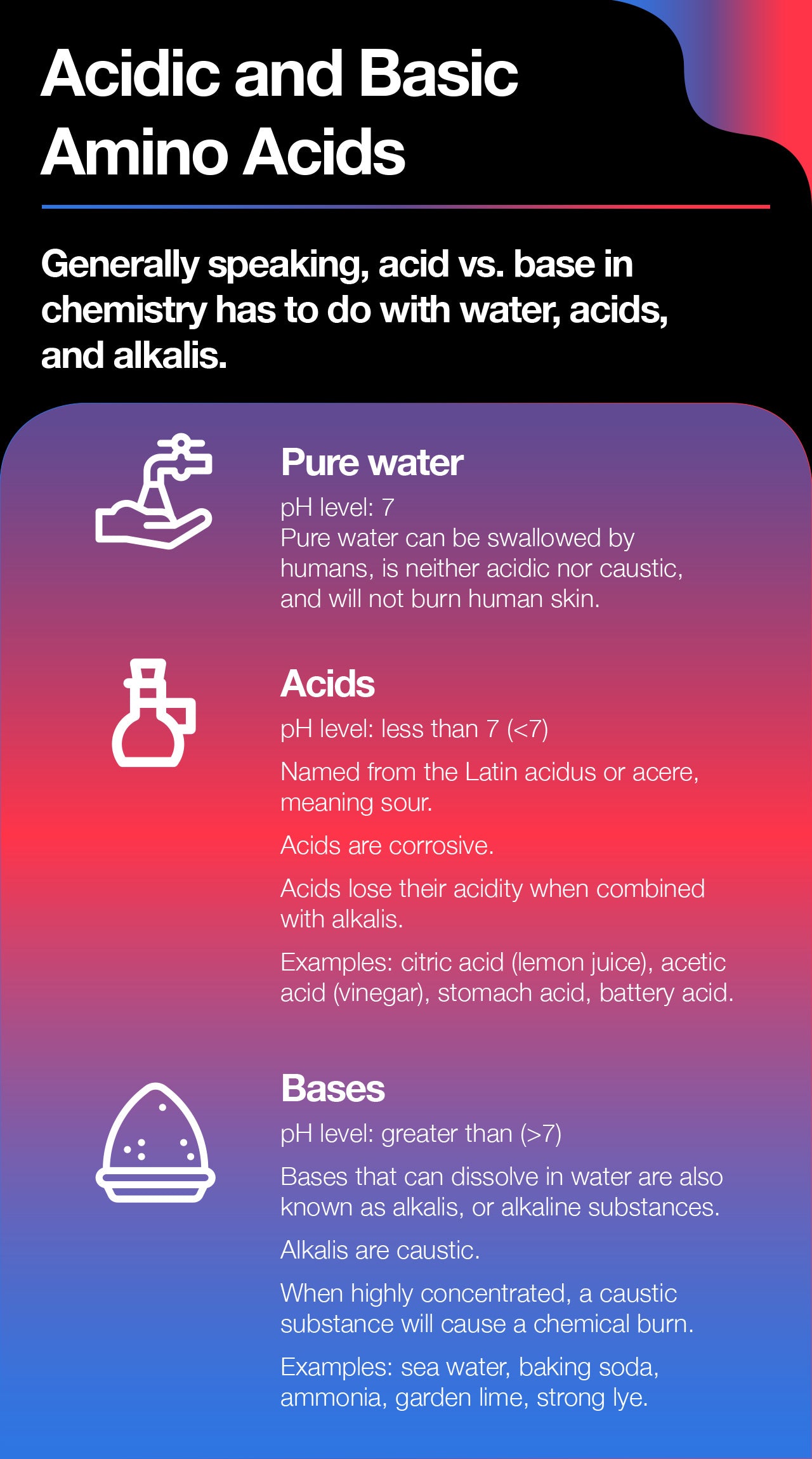Acidic and Basic Amino Acids Explained
 By: by Amino Science
By: by Amino Science

This article will quickly inform you of the difference between acidic and basic amino acids. We'll provide the definitions and explanations you seek, including what are amino acids, what makes some of them acidic and some of them basic, and why that matters when it comes to the chemistry of the human body.
Amino Acids: Essential vs. Nonessential
Amino acids are the buildings blocks of protein in your body. In short, when it comes to protein synthesis and literally building new muscle, you cannot do it without your amino acids.
Nonessential Amino Acids
Your nonessential amino acids are the amino acids your body can create on its own as a byproduct of normal functioning. There are 11 of these amino acids, and they include the following:
- Alanine (ala)
- Arginine (arg)
- Asparagine (asn)
- Aspartic acid (asp)
- Cysteine (cys)
- Glutamic acid (glu)
- Glutamine (gln)
- Glycine (gly)
- Proline (pro)
- Serine (ser)
- Tyrosine (tyr)
Essential Amino Acids
Your essential amino acids are the ones you need but cannot produce yourself, and so must be gained either from your diet or via supplementation. These amino acids include the following:
- Histidine (his)
- Isoleucine (ile)
- Leucine (leu)
- Lysine (lys)
- Methionine (met)
- Phenylalanine (phe)
- Threonine (thr)
- Tryptophan (typ)
- Valine (val)
Now that you know the amino acids we'll be talking about, let's move on to an illustrative example of what an amino acid's structure looks like.
Amino Acid Structure
To understand what differentiates amino acids, you'll have to understand their structure and what they have in common. Each amino acid is made of a central alpha carbon atom (Cα), and attached to that central atom are three molecular structures, also known as functional groups: one is a carboxyl group (-COOH), the second is an amino group (-NH2), and the third is a single hydrogen atom (H). This is the same structure of all amino acids, until the last piece of the puzzle joins the rest: the R group side chain. The R group you can think of as the Radical group, as it is different and unique on each and every amino acid, of which there are 20 main ones in the human body.
Picture it, if you will, as a group of lava lamps. Each one is made up of a light bulb in the center, a power cord, a stand, and a cap. With a long row of 20 identical lava lamps, imagine that the only thing that would make any of them unique is the color combination inside its radical glass lava vessel. Maybe one vessel has blue water and green lava, while another one has purple water with yellow lava, while yet another has blue water combined with yellow lava. With 20 different color combinations, you have enough to represent all 20 amino acids. The light bulb in the center? That is your central alpha carbon. The power cord? The carboxyl group. The supporting stand? Your amino group. And the little decorative cap on top? Your single hydrogen atom.
We illustrate it this way because it's that glass lava vessel that not only determines what kind of amino acid you have (i.e. what color your lava lamp is), but these side chains also determine whether or not an amino acid is basic or acidic. With that structure explained, let us next generally cover acid vs. base when it comes to a chemistry standpoint.
Acid vs. Base: The Basics About Acids
In chemistry, we're talking about molecules (which are themselves made up of atoms). A base molecule or compound is the opposite of an acid. Acids are the compounds that donate a hydrogen ion (H+) to a base, while a base compound is one that can remove a proton (H+ is a proton) from an acid. A strong base molecule can deprotonate, or take the proton, of a weaker acid such as water.

Water, Acids, and Alkalis
Hydrogen molecules are why bases and acids are often measured in pH levels (pH stands for "potential of hydrogen") as related to pure water. The pH scale goes from 0-14. The pH of pure water is 7, precisely in the middle.
When an acid is dissolved in water, it becomes a solution with higher hydrogen ion activity than water, making it more acidic, with a pH value less than 7. When a base dissolves in water, it creates a solution with lower hydrogen activity than water, giving a pH value greater than 7. Bases that dissolve in water are called alkalis. To summarize:
- Pure water
- pH level: 7
- Pure water can be swallowed by humans, is neither corrosive nor caustic, and will not burn human skin.
- Acids
- pH level: less than 7 (<7)
- Named from the Latin acidus or acere, meaning sour.
- Acids are corrosive.
- Acids lose their acidity when combined with alkalis.
- Examples are: citric acid (lemon juice), acetic acid (vinegar), stomach acid, and battery acid.
- Bases
- pH level: greater than (>7)
- Bases that can dissolve in water are also known as alkalis, or alkaline substances.
- Alkalis are caustic.
- When highly concentrated, a corrosive substance will cause a chemical burn.
- Examples are: sea water, baking soda, ammonia, garden lime, and strong lye.
To recap: the further you get from pure water on the pH scale, the more corrosive or caustic a substance becomes, and thus the more harmful to human skin (for example). On the low end of acids, you can drink orange juice, and on the low end of bases, you can swim in sea water. On the high end of acids, you have battery acid, and on the high end of bases, you have bleach, drain cleaner, and lye, which you may remember from the 1999 movie Fight Club. It occurred when Brad Pitt's character mixed human saliva with lye on Edward Norton's character's skin and stated, "This is a chemical burn. <...> You can use water and make it worse, or use vinegar to neutralize the burn." Vinegar is a 2 on the pH scale, an acid that can indeed neutralize a strong base like lye (a 13 on the pH scale).
Acidic and Basic Amino Acids
Of our amino acids, which are acidic, which are base, and why does it matter? First we'll state which is which, while quickly pointing out that the acidity of amino acids is measured with a pKa number, obtained by applying a logarithm; simply put, pKa measures acid strength, while pH measures the hydrogen content of a solution.
As a further example, for acids that means the smaller the pKa number, the more acidic the substance, and thus the lower the pH value.
Acidic Amino Acids
The two acidic amino acids are:
- Aspartate (aspartic acid)
- Glutamate (glutamic acid)
Acidic amino acids are those with acidic side chains, specifically containing carboxylic acid groups with pKa measurements low enough to lose protons and become negatively charged. Acidic amino acids are also by their nature hydrophilic amino acids (meaning they like water, as opposed to hydrophobic amino acids), and polar amino acids (meaning they are positively charged, as opposed to nonpolar amino acids).
Basic Amino Acids
The three basic amino acids are:
- Arginine
- Histidine
- Lysine
These basic amino acids are so classified because they have basic side chains containing nitrogen, which resemble ammonia (a base). The pKa values of basic amino acids are high enough to bind protons and give them a positive charge. By nature, basic amino acids are also polar amino acids, and are also hydrophilic, just like the acidic ones.
A for Acid, B for Base, C for Conclusion
In conclusion and to summarize: the difference between acidic and basic amino acids is the same as between any acid and base in chemistry and chemical substances. Their similarities still include being polar amino acids, as well as hydrophilic amino acids, and, of course, the biggest thing they have in common is that they're all still amino acids, with the same basic structure.
Though some are essential and some nonessential, the reason amino acids matter, and the reason that all these tiny permutations matter, is because without each of them working together, our health and well-being would fail. We at Amino Co. have developed amino acid supplements specifically because we understand their vital importance to human life. The chemistry behind each person's daily concert of amino acids is the science that drives our passion.

Up to 25% off Amino
Shop NowTAGS: knowledge
Join the Community
Comments (0)
Most Craveable Recipes




 833-264-6620
833-264-6620



















